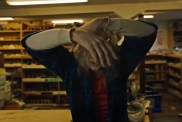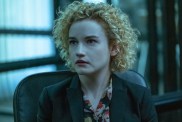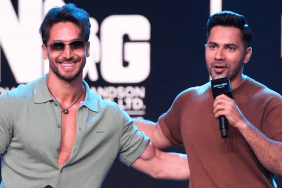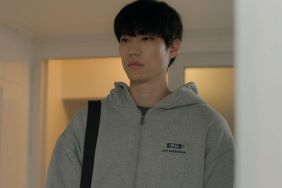Those who’ve been following the development of “Stargate,” ever since the concept was introduced in the 1994 movie by Roland Emmerich and Dean Devlin, will have a chance to explore new worlds aboard the starship Destiny with the premiere episode of the new series “SGU: Stargate Universe” on Syfy starting Friday, October 2.
Following on the heels of previous series “SG-1” and “Atlantis,” the new show involves a diverse group of people who have been stranded on the Destiny after escaping through a Stargate, and they have to work together to survive and uncover the mysteries of the ship.
ComingSoon.net had a chance to talk to two of the stars of the new series – Robert Carlyle, who is Dr. Nicholas Rush, the brilliant scientist who knows the most about the Destiny, and Ming-Na who plays Camille Wray, a high-ranking human resources officer. You can read our interview with Carlyle below and our interview with Ming-Na here.
American audiences first met Scottish actor Robert Carlyle when he co-starred in Danny Boyle’s Trainspotting, followed quickly by his part in The Full Monty and other mainly British films–he even did a stint as a Bond baddie in The World is not Enough). “Stargate Universe” is his first major television show in the United States, in which he plays Dr. Nicholas Rush, the genius scientist who seems to know a lot more about the Destiny’s workings than the others who end up onboard.
ComingSoon: Tell me a little bit about your first exposure to the “Stargate Universe.” Do you recall seeing the original film or any of the other series?
Robert Carlyle: Yeah, I do. The film is my main reference point to the whole thing. I was aware of “SG-1” and “Stargate Atlantis,” but it wasn’t stuff, to be honest, I had watched. Until it was put to me if I was interested. I started to watch a lot of this stuff and I thought, “This is an interesting world.” Again, to be honest, I was more impressed by “SG-1” than “Atlantis,” but I thought, “Well, there’s something in here.” Again, I was still reluctant because it was such a different kind of thing for me. Eventually, I had some phone conversations with Brad Wright and Robert Cooper, and this is the first thing that I said to them, I said, “Guys, I’m really flattered, but why do you want me to do this?” There was silence. I don’t think anybody’s ever said that before. They said, “Well, you know,” I said, “I’m just being honest because I don’t see myself trying to go down that road. It’s not me.” He said, “Well, that’s exactly why we’ve come to you.” I thought, “Oh, okay.” So, a fellow cast member trying to make me laugh, “That’s why we’ve come to you.” I was like, “Oh, I’m doubly flattered now.” So I said, “Okay, well, let me see what you’ve got.” They sent the script and so, “You guys are telling the truth. This is actually quite complex, the stuff you’re asking here, you know?” You’re looking for a particularly Dr. Nicholas Rush. You’re looking at a really complex character, as complex as anything I’ve played for sure, very, very deep. A very difficult man. (Laughs) So, that was it. The bait was set.
CS: Give me a little insight into Dr. Rush… he’s a man with some secrets.
Carlyle: For sure. See, the thing is, I don’t really know what too many of the secrets are–and I’m being serious about it–because the way that I kind of started off working in my professional life was British independent film and all of that. The guy I worked with in the beginning was a guy called Ken Loach and Ken never gave me the script. You never had the script. He did that intentionally because he thought, “I don’t want you getting too comfortable. Just be… don’t think beyond.” I’ve always kept that in mind. Whenever I’ve had that opportunity to do that I’ve always used that and thought, “Well actually, well I don’t want to know.” Play the moment, play this moment here. I’m not too sure maybe what lies around the corner and I’m not even too sure if the scriptwriters know what’s around the corner, but he is full of contradictions. You’re not sure what the guy’s about. It’s a difficult thing to describe until you’ve seen it, to be honest. What Brad and Robert said to me, they said, “Look, we’re looking for someone that can make unattractive things seem quite attractive.” That’s a kinda conundrum in itself, that’s intense, but I knew what they meant by that. So, you’re looking for a guy who takes actions which are actually quite objectionable, but he does it in such away that he is actually quite attractive. (Laughs) So is he a villain? Is he a hero? He’s neither, he’s neither, but he walks a very, very, very thin line, you know? As an actor, as a performer, I hardly do that because if I go too far on the kind of nasty, nasty side I’ll alienate the whole audience, but if I go too far in a jokey, happy side then I don’t have the power. So, I mean, right here. (Laughs)
CS: Tell me a little bit about the way they’re shooting the show. I understand a lot of the footage is being shot almost in a pseudo-documentary fly on the wall kind of way?
Carlyle: The thing is that even a normal shooting, we’re working with two or three cameras, but everyone’s moving all the time. The marks are movable. You can go where you want, that’s the wonderful thing about it. When you go on set in the morning you just plop where you want to be and they’ll find you. You don’t sit or stand there where there’s a lot of light. The light is kinda 360 in a way. So, this is very, very fluid and then they added what I think is a brilliant idea, they discover it on the ship, the Destiny, this thing which they call Kino it’s a ball, it’s a camera and it floats around. One of the characters, played by David Blue, he kind of takes this thing under his wing and he says, “Well, I’m gonna document this whole experience that we are having here.” So, a lot of the scenes are shot on one single shot on this Kino camera, which again, I’ve never seen anything like that done in a science fiction show. Everything’s generally sleek and pin sharp. This was hand-in-hand with the Destiny Ship which has been floating around for hundreds of thousands of years. It’s rustic, it’s ancient. There’s nothing comfortable about it, so this Kino style is used to great effect particularly in an episode called “Time” where they actually go onto an alien planet. I would say 75 percent of the action takes place on the alien planet. It’s all shot on Kino, all of it. It’s very brave. They’re taking a lot of chances with us, but it’s a brave kind of thing the way they’re trying to take it.
CS: What about life on a dead ship? Like you said, this is a very old, ancient, unkempt vessel. There’s gotta be issues with food and water and life support.
Carlyle: Well, strangely enough the first four to five episodes are called “Air” where there’s problems with life support and with water. That’s exactly what we address and it is about survival. I know this is mainly a buzz kinda thing, but what they discover very soon once they go on the ship is no one’s actually ever been there before. They’re sent out unmanned, this is a series of ships that are there to seek the Stargates, gather information and go back there. There’s facilities there for people to be, these ships at one point and then they maybe ascended and didn’t need the ships anymore. I think the first five or six (episodes) all concern themselves with that basic problem and this is a very natural fact because one of the things that I said to the producers at the beginning when I was doing a wee bit of my own little research. “I remember these guys all come out with beards, longer hair.” I said, “Why doesn’t anybody shave in space?” Then I come up with this line, like in the famous line, “In space, no one can hear you scream,” but in space you can always get a haircut. (Laughs)
CS: So those could be further episodes: Air, Water, Deodorant, Shampoo…
Carlyle: The cast always jokes that we have an episode called “Chocolate.” (Laughs) But you can see the sense of what we’re trying to kinda do there. This is what’s happening to me that by the end of the 20th episode the beard will be filling in. I started off and the hair was a little shorter, so I think it’s only right to do that, and the rest of them are beginning to join in, beginning to grow and everything, so they definitely worked with us.
CS: So, you have the ship that sees these Stargates and you have this Alice through the looking glass of these planets with nearby gates. Can you fill us in on some of the planets we’ll be seeing as the series starts? (NOTE: There are some serious spoilers in this response for the first couple episodes.)
Carlyle: Yeah, the first one that they encounter… I suppose the first thing you have to understand about the Destiny is that they can’t control the ship. They’re not flying it. They can only get access to a portion of the navigation systems and this is, still by episode 12 they still haven’t. They’re at the mercy of the ship in a sense and the ship is an FTL–faster than light–and then stops when it comes out and the FTL timer starts and the Gate pops up to something there, so they can go through or not. The first three hours in the pilot I guess their life support is dying, so Rush punches all this stuff on the computer and the ship itself finds these planets and the ship knows it’s in trouble, it knows that they need air and how do you get air? There’s these things inside the ship called Scrubbles, where there’s limestone, which cleans the CO2 out of the air. These things are overloaded when they arrive, so they go to this planet–and we shot it in New Mexico on the Holloman Air Force range, the white sands, 140 miles by 40 miles, white, as white as your notepad, the sand. You have to put sun block in your nose and your ears. It bounces up, 120 degrees. I have to tell you, the footage of that, it looks like f*cking “Lawrence of Arabia,” it’s absolutely stunning. So, the desert planet is the first planet that we visit. A few people have hallucinations and stuff out in the sands and stuff as well. So there’s there, and they visit what we call the jungle planet after that. The jungle planet is… I have to say, I’m still trying to get my head around the episodes, it’s called “Time.” The ship stops. A warm puddle appears. Some of them go through them and they get through to the planet. There’s a Kino line there on the surface, so they bring it back and they play through it and it’s them and they all got attacked and they all die. It’s like, “What the f*ck happened there?” So they’ve been there, then we can prevent going there again. So there’s a wonderful image at the end when Rush is on the planet and he picks up this skull which is actually himself. (Laughs) That’s pretty deep for a sci-fi show.

CS: That’s pretty in-depth for what’s going on here, and I understand you have a great set in Vancouver that y’all are shooting this on.
Carlyle: Yeah.
CS: Tell me a little bit about being up there and working there.
Carlyle: Well, Vancouver’s a wonderful city to be in. I’ll tell you ’cause when I’ve seen it at first when they took me on, I mean, the set is pretty big, so be prepared. This is really big. It blew me away because the only reference point I had was “Bond.” It’s as big as that, absolutely enormous. The Destiny Ship is as big as a set as I’ve ever been in and a massive iron staircase in it. Wonderful, wonderful set design. I think each episode is costing somewhere in the region of $2 and a half million.
CS: That’s pretty steep for a television show.
Carlyle: It’s all on the screen; it’s all there in front of you. It really is filmed beautifully. It’s f*cking ambery kind of color. This color palate I guess is browns and grays and blues, a beautiful set.
CS: So you’ve shot about a dozen episodes already?
Carlyle: Yeah, we’re at exactly 12.
CS: There’s a handful more to go?
Carlyle: Eight to go on this one, yeah.
CS: Are you still purposely keeping the scripts from yourself so you don’t know too much?
Carlyle: I don’t want to know too much. I’ll tell you why, because another part of it is for me, I’m a guy that’s been used to doing features really and you do two, three months and you’re home and it’s over. This is a different animal so I’ve had to kinda get my head around it in a slightly different way. How I’m seeing it is, if the magic number on all these shows is five and we only go five seasons, then I can’t think about 100 f*cking episodes. Even at the moment 20 is kinda beyond me and I’ve kind of passed this new technique onto the cast and it’s working for me as I’m seeing it as a five act drama really. This is the first act and I’m looking forward to getting back and completing the first act of this five-act piece. I think the character’s got a long, long way to go. I think that the stuff that I’m talking to the producers about in terms of the character, if we go down this road I think the revelations will be quite incredible about this character. So I’m really looking forward to I don’t want to think of it. That frightens me. I like to think about the now.
CS: Is there a love interest for the Doctor?
Carlyle: No, the Doctor’s alone.
CS: He’s a loner?
Carlyle: No, he’s just alone. A bit of the backstory I suppose is he was married. His wife died of a debilitating, crippling illness that lasted several years. He wasn’t there and this is what he’s carrying with him and there’s actually a point in the first episode. No one sees this, Rush goes into his quarters and he just breaks down, he cries, this photograph of his wife. This has been a part of his problem I think and the reason why he could quite easily go, “I’m off into space and I’m never f*cking coming back.” So I think there’s something really quite profound about the guy. I don’t think love is in the cards for Rush.
CS: What about, do you have any other future work happening right now? What happened to “Iron Clad?”
Carlyle: “Iron Clad” is happening. I’m going to go out and do that in December in fact, November, December. So you know about that one?
CS: I recall your name being attached to that, and it takes place in the 11th or 12th Century?
Carlyle: It’s set right after the signing of the Magna Carta, King John and all of that. Everyone knows about the Magna Carta, very few know what happened next. King John, once the rebel army had been appeased, they said, “Okay, power to the people. Have you gone? I’m back.” So, this group of people who didn’t trust him, it’s a group of guys, they waited behind and went to this castle in Worchester, Worchester Castle, which was really the fixing pendant of all of Britain at that point. Whoever controlled that they controlled it these 12 guys held it against thousands. I’m one of the guys. (Laughs)
CS: Sounds great. Anything else on the slate for you?
Carlyle: I’ve got a couple things that may be showing here soon. One thing in particular, a little lovely movie called “I Know You Know” which was a really lovely film. It’s a true story in fact. It’s actually the director’s own story. The director’s father convinced everyone that his family, that he was actually a secret agent, that he was working for MI-5. When I read this, when I got the script, I thought, “This is a secret agent movie.” But he was mentally ill, and he kinda deteriorated more and more and more. It’s very much me and the kids. It’s me boy who’s playing the director in fact as a child. I really, really loved that. We filmed and, I hope… I don’t know, my God, some of these wee independent, low-budget British movies that I do. You’re lucky if I see them with f*cking three people, you know? Maybe you’ll be the fourth.
Check out our interview with Ming-Na here.









